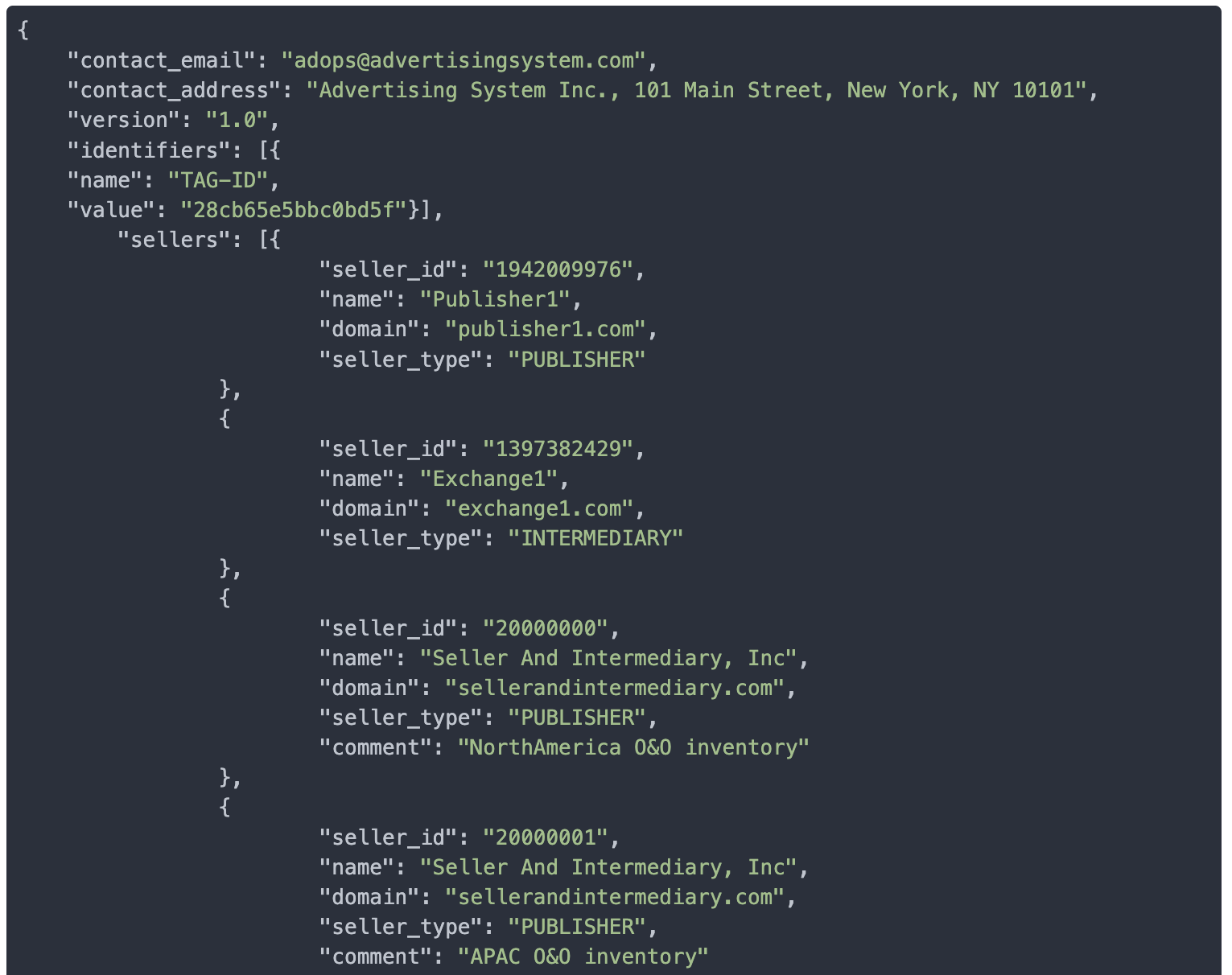In this article, we discuss everything you need to know about the Interactive Advertising Bureau’s (IAB) sellers.json files! We look at: sellers.json vs ads.txt, sellers.json examples, sellers.json use cases, and more.
Recently, we wrote about the IAB’s app-ads.txt standard. We noted that as advertising on mobile and connected TV (CTV) platforms has flourished, ad fraud in those spaces has become far more prevalent. With app-ads.txt and sellers.json, advertisers, publishers, and businesses across the digital advertising landscape can take measures to counteract the associated threats.
To help out, we’ve written this article covering the ins and outs of sellers.json. Here’s what we cover:
- • What Is Sellers.json?
- • How Sellers.json Works
- • Sellers.json vs Ads.txt
- • Why Is Sellers.json Important?
- • Sellers.json Benefits and Uses
- • Sellers.json Examples: How Businesses Can Use Sellers.json
- • Sellers.json Use Cases for App Developers and Publishers
- • Sellers.json Use Cases for Advertisers
- • Sellers.json Use Cases for Ad Networks and Exchanges
- • Sellers.json Use Cases for Programmatic Platforms
- • Get Easy Access to Sellers.json Insights
Ready to get started? Try our IAB Category APIs and file dumps.
What Is Sellers.json?
Sellers.json is a transparency tool for the digital advertising ecosystem that was developed by the Interactive Advertising Bureau Tech Lab (IAB Tech Lab). Its purpose is to ensure that inventory is being sold by authorized entities, reducing the chances of fraud and unauthorized sales.
Here’s how it works. Supply-side platforms create JSON files listing all entities that are allowed to sell their digital ad inventory. They then make these files publicly available, enabling ad space buyers to easily verify direct and intermediary sellers.
For buyers, sellers.json makes it easy to verify the entities from whom they are purchasing inventory. For publishers, it provides an additional layer of security against domain spoofing and unauthorized inventory sales.
Key points about the IAB Tech Lab’s sellers.json standard:
Transparency: The primary goal of sellers.json is to bring transparency to the supply chain. By making these files available, SSPs can clearly indicate which partners are authorized to sell their inventory. This helps buyers verify the authenticity of the inventory they purchase.
Contents: The file contains details about each seller, including their name, domain, seller ID, and more. It can also indicate whether a particular seller is a direct seller (like the publisher itself) or an intermediary (like an SSP or an ad exchange).
Complementary to app-ads.txt and ads.txt: While sellers.json provides information from the supply side, ads.txt (Authorized Digital Sellers) and app-ads.txt are standards that allows publishers to declare who is authorized to sell their inventory. When used together, these tools offer a comprehensive view of authorized sellers and resellers in the mobile, connected TV (CTV), and digital ad space.
To make their sellers.json scanning processes more efficient, DSPs can also use third-party solutions to view aggregated sellers.json data. For example, at 42matters, we provide sellers.json insights for 20+ million published and unpublished apps via our sellers.json file dumps. These offer insight into sellers.json files for iOS and Android apps and connected TV (CTV) apps available on Roku, Apple TV, Fire TV, Google TV, Samsung TV, LG TV, and Vizio.
How Sellers.json Works
As touched on above, sellers.json works by providing a publicly accessible record of all parties that are authorized to sell an SSP’s digital inventory. Here's a step-by-step breakdown of how it operates:
STEP 1: Creation by SSPs and Exchanges
Supply-side platforms (SSPs), ad exchanges, and other sell-side entities create a sellers.json file. This file lists all the entities (publishers and intermediaries) that are authorized to sell inventory through that particular platform or exchange. Each entry in the sellers.json file should include: Seller ID, Seller Domain, Seller Type (direct or intermediary), Seller Name, and optional details like contact information, payment types, etc.
STEP 2: Public Accessibility
The SSP or ad exchange makes the sellers.json file publicly available on their domain, or a domain that they manage, typically at a predictable location like https://<domain>/sellers.json.
STEP 3: Verification by Buyers
When a buyer (like an advertiser or agency) wants to purchase inventory, they can check the sellers.json file of the SSP or exchange they're buying from. By cross-referencing this file with the publisher's app-ads.txt or ads.txt files, buyers can verify their ad purchases at multiple levels.
STEP 4: Regular Updates
SSPs and exchanges should regularly update their sellers.json files to reflect any changes in their list of authorized sellers.
STEP 5: Integration Into Industry Tools & Platforms
Many programmatic platforms and tools now incorporate sellers.json checks as part of their buying process, automating the verification process for buyers. For example, by using our sellers.json file dump in parallel with our app-ads.txt file dump, programmatic platforms can reduce ad fraud without spending extra time on ad seller and app publisher verification.
Sellers.json vs Ads.txt
One of the most common questions about the sellers.json standard is how it differs from other IAB ad fraud prevention standards. In particular: ads.txt. While they serve related purposes, they operate from different perspectives and have distinct functionalities. Here's a comparison of the two:
| sellers.json | ads.txt |
|---|---|
| Purpose: sellers.json provides a way for SSPs and ad exchanges to disclose the list of publishers and intermediaries authorized to sell inventory on their platform. It complements ads.txt by offering transparency from the sell-side. | Purpose: ads.txt allows publishers to declare which companies are authorized to sell their digital inventory. It's a way for publishers to publicly state which SSPs, ad exchanges, and other intermediaries can sell their inventory. |
| Perspective: It's from the SSP's or ad exchange's perspective. | Perspective: It's from the publisher's perspective. |
| File Location: Hosted on the SSP's or ad exchange's domain or a channel they manage. | File Location: Hosted on the publisher's domain or on a channel managed by them. |
| Contents: Lists details about each seller, including their name, domain, seller ID, and type (direct seller or intermediary). | Contents: Lists the authorized partners (SSPs, ad exchanges) with their domain name, publisher's account ID, relationship type (direct or reseller), and an optional certification ID. |
| Benefits: Offers transparency into the supply chain from the sell-side. | Benefits: Helps prevent unauthorized inventory sales and domain spoofing. |
When used together, these tools provide a comprehensive view of the authorized sellers and intermediaries in the programmatic advertising space, ensuring a transparent and trustworthy ecosystem.
Read our report on the state of app-ads.txt and sellers.json.
Why Is Sellers.json Important?
Sellers.json is important for a number of reasons, primarily centered around enhancing transparency, trust, and security in the digital ad space. It’s particularly popular in the mobile and connected TV (CTV) advertising industries. So, let’s look at some benefits and uses of the sellers.json standard.
Sellers.json Benefits and Uses
Sellers.json can be used for…
- • Supply Chain Transparency
- • Combating Domain Spoofing
- • Reducing Unauthorized Inventory Sales
- • Enhancing Buyer Confidence
- • Complementing ads.txt and app-ads.txt
- • Streamlining Auditing and Reconciliation
Supply Chain Transparency
sellers.json provides a clear view of all entities that are authorized to sell a publisher's digital inventory. This transparency allows buyers to understand who is involved in the transaction and the role they play, whether they are a direct seller or an intermediary.
Combating Domain Spoofing
Domain spoofing is a fraudulent practice where bad actors misrepresent inventory as being from a premium publisher to fetch higher prices. With sellers.json, buyers can verify the authenticity of the inventory they're purchasing, reducing the chances of falling victim to such scams.
Reducing Unauthorized Inventory Sales
sellers.json ensures that only authorized entities are selling a publisher's inventory. This helps in preventing unauthorized sales and reselling, ensuring that publishers retain control over who sells their inventory.
Enhancing Buyer Confidence
By providing a mechanism to verify the authenticity of inventory sources, sellers.json boosts the confidence of buyers in the programmatic buying process. This can lead to increased investments in programmatic channels.
Complementing ads.txt and app-ads.txt
When used in conjunction with app-ads.txt and ads.txt (standards that allows publishers to declare who is authorized to sell their inventory), sellers.json offers a comprehensive view of the supply chain from multiple perspectives. This dual-layer of verification further strengthens the ecosystem's transparency.
Streamlining Auditing and Reconciliation
With a clear record of authorized sellers and intermediaries, advertisers and agencies can more easily audit and reconcile their programmatic ad spend, ensuring that their investments align with genuine inventory sources.
Here are more ways ad tech companies can enhance their mobile advertising strategy.
Sellers.json Examples: How Businesses Can Use Sellers.json
Companies can leverage sellers.json in varying ways, depending on their role in the mobile advertising ecosystem. Below we breakdown how different entities can use sellers.json. We focus on:
- • App Developers and Publishers
- • Advertisers
- • Ad Networks and Exchanges
- • Programmatic Platforms
Sellers.json Use Cases for App Developers and Publishers
For app developers and publishers, sellers.json plays a crucial role in ensuring transparency and trust in the programmatic advertising ecosystem. Here are some specific use cases for app developers and publishers:
Inventory Control: Publishers can ensure that only authorized entities are selling their app's ad inventory. By working with SSPs and exchanges that rely on the sellers.json standard, publishers can have better control over who is representing their inventory in the market.
Combating Unauthorized Reselling: If a publisher has exclusive agreements with certain SSPs or ad exchanges, they can use sellers.json to monitor and prevent unauthorized reselling of their inventory by other parties.
Optimizing Monetization Partners: By analyzing the sellers.json files of various SSPs and exchanges, publishers can identify which partners have a broader reach and more direct relationships, potentially leading to better monetization opportunities.
Integration with Ad Mediation Platforms: For app developers using ad mediation platforms to manage multiple ad networks, sellers.json can provide insights into the transparency and authenticity of these networks, aiding in the selection process.
Enhanced User Experience: By working with legitimate and transparent ad partners, publishers can ensure that their users are served relevant and high-quality ads, leading to a better user experience.
Sellers.json Use Cases for Advertisers
Now let’s take a look at some use cases for advertisers:
Inventory Source Verification: Advertisers can use sellers.json to verify the authenticity of the inventory sources they are purchasing from. This ensures they are buying genuine inventory from legitimate sources, reducing the risk of purchasing misrepresented or fraudulent inventory.
Combating Domain Spoofing: Domain spoofing is a fraudulent practice where bad actors misrepresent low-quality inventory as being from premium publishers. By reviewing sellers.json files, advertisers can confirm that the inventory they are purchasing genuinely belongs to the claimed publisher, helping to combat this type of fraud.
Auditing and Reconciliation: Advertisers can use sellers.json as a reference during auditing processes. It helps in reconciling ad spend, ensuring that investments align with genuine inventory sources, and verifying that they are billed correctly.
Strategic Decision Making: Along the same lines, advertisers can analyze sellers.json data to identify which SSPs, ad exchanges, or direct publishers are most aligned with their target audience and campaign objectives, aiding in strategic decision-making.
Enhancing Brand Safety: By ensuring that ads are placed on legitimate and relevant inventory, advertisers can maintain and enhance their brand's reputation and safety.
Sellers.json Use Cases for Ad Networks and Exchanges
Moving on. Here are some ways ad networks and ad exchanges can use sellers.json files:
Transparency for Buyers: By providing sellers.json files, ad networks and exchanges offer transparency to buyers about all the entities authorized to sell inventory on their platform. This transparency helps build trust and confidence among advertisers and agencies.
Combating Fraud: sellers.json acts as a deterrent against fraudulent practices, such as domain spoofing. By listing authorized sellers, it becomes harder for bad actors to misrepresent inventory or engage in unauthorized reselling.
Building Trust with Publishers: By supporting and implementing sellers.json, ad networks and exchanges demonstrate their commitment to transparency and best practices, which can strengthen their relationships with publishers.
Competitive Advantage: In a market that values transparency and trust, ad networks and exchanges that adopt sellers.json can position themselves as more trustworthy and compliant, potentially attracting more publishers and advertisers to their platform.
Streamlined Operations: sellers.json can help ad networks and exchanges streamline their operations by providing a clear record of authorized sellers, making it easier to manage partnerships and handle any discrepancies or disputes.
Improved Negotiations: With transparency into the supply chain, ad networks and exchanges can have better negotiations with both publishers and advertisers, ensuring fair deals and optimizing revenue.
Attracting Quality Advertisers: Advertisers prefer to work with transparent and trustworthy partners. By implementing sellers.json, ad networks and exchanges can attract quality advertisers who value transparency and are willing to invest more in genuine inventory.
Sellers.json Use Cases for Programmatic Platforms
Programmatic platforms, which include Demand-Side Platforms (DSPs), Supply-Side Platforms (SSPs), and Data Management Platforms (DMPs), play a central role in the digital advertising ecosystem. Here’s how they can benefit from sellers.json:
Inventory Verification: DSPs can use sellers.json to verify the authenticity of the inventory sources they are purchasing from, ensuring that they are buying genuine inventory from legitimate and authorized sellers.
Transparency Enhancement: SSPs can provide a sellers.json file to offer transparency to buyers about all the entities authorized to sell inventory on their platform. This helps in building trust with DSPs and advertisers.
Combating Fraud: sellers.json acts as a tool to deter fraudulent practices, such as domain spoofing and unauthorized reselling. Programmatic platforms can ensure that only authorized entities are involved in transactions, reducing the risk of fraud.
Risk Management: By verifying the authenticity of sellers and inventory, programmatic platforms can manage and mitigate risks associated with fraudulent activities, protecting their reputation and their clients' investments.
Building Trust with Partners: By supporting and implementing sellers.json, programmatic platforms demonstrate their commitment to industry best practices, which can strengthen their relationships with both publishers and advertisers.
Operational Efficiency: With a clear record of authorized sellers, programmatic platforms can streamline their operations, manage partnerships more effectively, and handle any discrepancies or disputes with greater clarity.
Improved Negotiation and Pricing: With transparency into the supply chain, programmatic platforms can have better-informed negotiations with partners, ensuring fair pricing and optimizing revenue opportunities.
And that’s that! To learn how to access app-ads.txt files easily and at scale, check out our sellers.json file dumps over at 42matters!
Get Easy Access to Sellers.json Insights
42matters is a leading mobile and connected TV (CTV) app data and app store intelligence provider. Our APIs, file dumps, and visual app market research platforms offer insight into tens-of-millions of mobile and CTV apps from 12 leading app stores. This includes the Apple App Store, Google Play, Amazon Appstore, Tencent Appstore, Huawei App Gallery, Roku Channel Store, Apple TV tvOS App Store, Amazon Fire TV, Google TV, Samsung Smart TV Apps, LG Content Store, and Vizio SmartCast Apps.
For a full rundown of the sellers.json file dump’s schema, check out the documentation on our website!



